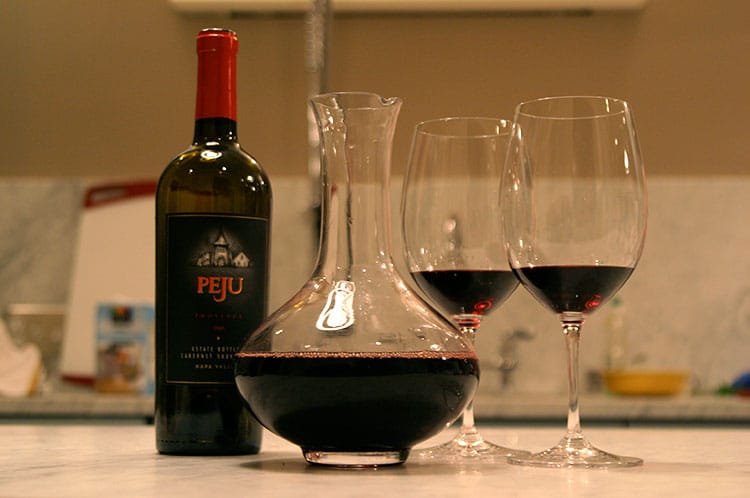• by Jenny Benzie, Advanced Sommelier and Proprietress of Épernay Wine & Spirits •
Summertime on Nantucket means that strict rules about wine pairings and decanting wine can be left back home in the city or suburbs. Here, you can throw caution to the wind and take chances to make your wine experience fun, memorable, and perhaps even a work of art.
This is for people who have always wondered what the big hype is about decanting wine, how to do it properly, and what constitutes an acceptable vessel for decanting.
Any wine, including Champagne, White Burgundy and especially Port, can be decanted. There are several key reasons for decanting wine. The most common reason that comes to mind is to remove the wine from any sediment that may have collected in a bottle while it has been aged in the cellar.
For this, you will need a napkin-lined basket, a candle in a holder, and a match. It is important to gently pull the bottle from the cellar in the same direction that it was stored without turning it upright or twisting it in anyway so that it lays flat in the basket. The neck of the bottle should be angled slightly. This allows you to remove the foil and extract the cork while the bottle is on its side without disturbing the sediment inside and not spilling any wine. You will need a candle to view through the shoulder of the bottle (just below the neck of the bottle – same as a person!) as you start to pour. When you see the fine-grained sediment appear, this is when you stop pouring the wine. Do not go back and forth when decanting, but pour a slow, steady stream so that your wine does not end up looking like muddy water. Think of it as handling your delicate Grandma with extra special care. Make sure to light the candle before you open the wine so that the smell of the match does not interfere with the smell of the wine. Don’t have a candle or match? A small flashlight that you can shine upwards is a great alternative.
Double decanting is when you pour the wine from the bottle into one vessel then you pour it into another vessel. It could be that you pour the wine back into the original bottle that it came from. This is where a funnel comes in handy. In this case, I recommend that you give the original bottle a small water rinse in order to remove the fine grainy sediment from the bottle. Shake out as much excess water as possible. Then, it is important to rinse the bottle a second time with a small amount of wine that was from the bottle. This will clean and coat the bottle properly before you use the funnel and pour the original wine back into the bottle.
Another reason for decanting wine comes to light when you have a young wine. In this case, your concern is not so much with the sediment that may have collected on the side of the bottle (although there may be some sediment in the bottom of the bottle, so beware). Rather, a young wine may need to open up so that it can breathe and aerate. In this instance, you can open the bottle normally and glug, glug, glug it into the decanter. The more surface area that the wine receives, the faster that it will open up for you. Don’t be afraid to slosh it around.
What if you don’t have a traditional decanter on hand? Decanters don’t have to be fancy or even glass for that matter. There are several companies that make amazing recyclable, reusable, shatter resistant plastic decanters, complete with convenient finger dimples. These types of decanters are great for taking poolside, to the beach, or on a picnic. You can put the decanter in an ice bucket without worrying about breaking any glass in the ice or having a glass bottle in the pool area that may slip out of someone’s hand and shatter. When you are at a rental house or staying with friends who are not wine aficionados, any glass water pitcher (or even a blender pitcher) will be perfect as they already have pour spouts ready for use.
A great way to liven up the party is to decant into a porron, a traditional glass wine pitcher from Spain that is a cross between a wine bottle and a watering can. A spout comes out from the bottom of the pitcher that gradually tapers off to a small opening. The lack of contact with the lips when pouring from a porron allows a group of people to share the same vessel without offending their sense of hygiene.
For those who do have a beautiful crystal decanter collection (which doubles as a magnificent art display!), you can decant several different wines at the same time. Remember that whatever you use as your decanter should be clear so that you can see the color of the wine inside it. (Unless of course you are doing a blind tasting experiment; in that case, an opaque pitcher would be acceptable.)
To properly clean your decanter, rinse it thoroughly with hot water only, and polish with a Wubeez polishing cloth (the best I have yet to discover!). Do not use bleach to get the red wine stains out or paper towels to dry it. Both of those will leave a treacherous odor that will taint your wine the next time you use the decanter. A quick and easy trick to get rid of red wine build-up is to put crushed ice and kosher salt into the decanter and swirl away. Both are natural ingredients, and the coarseness of the two will break up the “tannin” buildup. If this doesn’t work, drop a tablet of denture cleaner in there and let it do the work for you.
Decanting is not hard work and it can be a lot of fun. It is great to practice decanting with any wine you open and experiment with different decanting vessels. That way, when the time comes for you to open that expensive wine and impress the future investors of your hedge fund, you will already know how to properly decant and leave them with a lasting impression.



